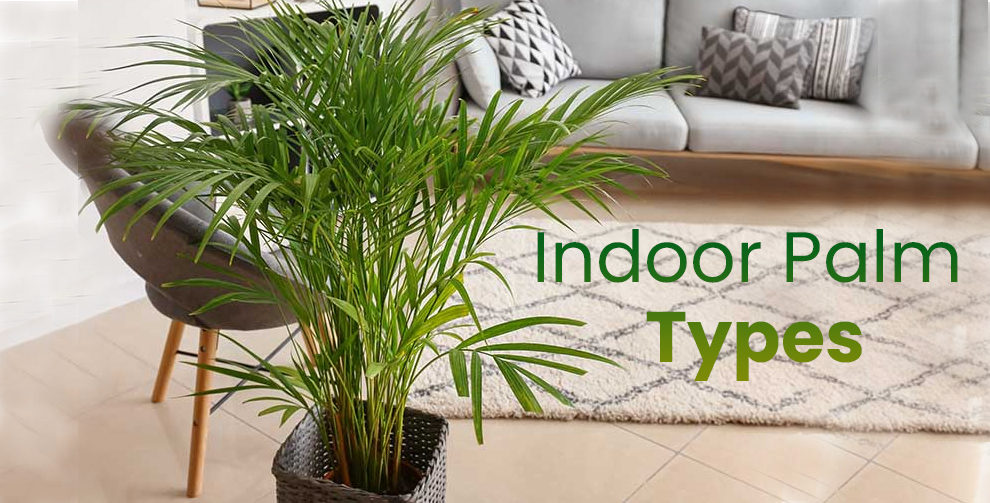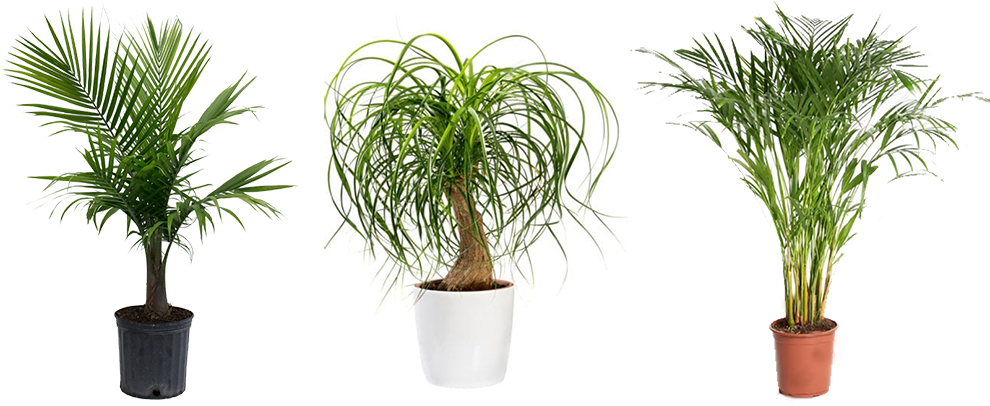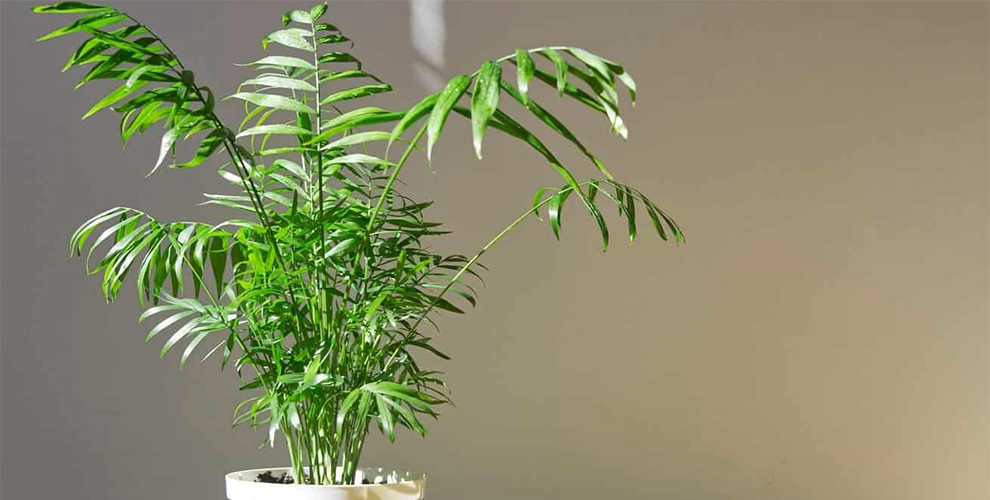10 Different Types of Indoor Palm Trees & Palm Plants

If you are confused looking at types of indoor palm plants for your house, then you ought to read this article.
Palm trees are among the most widely grown variety of plants in the world. But, surprisingly, they’re also popular as houseplants and they never fail to add charming additions to any indoor plant collection.
So, do not forget to enhance the charisma of your house by adopting a beautiful indoor palm tree. Let us quickly dive in to different indoor palm plants that you can buy for indoor use.
Jump To
Types Of Indoor Palm Trees and Conditions Necessary For Their Survival

1. Majesty palm
- How do they look: One of the most attractive varieties of indoor palm trees, when majesty palm trees are young, they resemble kentia palm and when they turn mature, they resemble the royal palm trees.
- Height: It is one of the slow-growing plants with a growth rate of a foot per year, the maximum height attained by majesty palm is 10 feet.
- Botanical name: The botanical name of majesty palm is Ravenea revularis.
- Water requirement: Watering requirement completely depends on the size of the plant. But do not forget to water them once every week as the soil should be kept moist but not logged with water.
- Temperature: The most suitable temperature range for these types of house palms is between 65 to 85 degrees Fahrenheit.
- Sunlight: Sunlight lovers, majesty palm thrives well when they are provided with six to eight hours of bright sunlight. If you have an indoor majesty palm, then it is advisable to keep them at the place where sunlight approaches well.
- Pet/kid-friendly: Majesty palms are non-toxic in nature, so you need not worry if you have kids or pets in your house.
- Lifespan: Majesty palm can easily survive for a good twenty to twenty-five years.
Did you know? Majesty palm can grow as big as 50 feet in height and 15 feet in width if they are grown in optimal conditions.
Related: Best Majesty Palm Soil | Ponytail Palm Soil Mix
2. Ponytail palm
- How do they look: As the name suggests, this plant has long leaves coming out from the top of the trunk, just like a ponytail.
- Height: Ponytail palm can attain a height of 30 feet if grown in optimal conditions and taken care of.
- Botanical name: The botanical name of ponytail palm is Beaucarnea Recurvata.
- Water requirement: It is one of the indoor palm varieties that can survive for long periods without water, which is a different case compared to different indoor palm plants. That is not to say you should never water them, but you really do not want to over-water them. Permit the upper 2 to 3 centimeters of soil to dry between waterings, then water the plant.
- Temperature: The optimal temperature range for ponytail palm is sixty to eighty degrees Fahrenheit. The trunk of the ponytail palm acts like a camel’s hump, which helps to bear low humidity of up to fifteen degrees Fahrenheit.
- Sunlight: Always be mindful to keep the plant in the place where sunlight makes its way easily, but do not keep them under direct sunlight.
- Pet/kid-friendly: One need not be concerned about the pets and kids as ponytail palm is completely safe for them.
- Lifespan: On average, ponytail palm can outlive humans. Ponytail palm lives for more than 100 years of age.
Did you know? The fun fact about ponytail palm is that it is neither a tree nor a palm. Indeed, it is a member of the Agave family native to Mexico’s southern desert.
3. Areca palm
- How do they look: The full and narrow fronds of areca palm resemble bamboo leaves. The very fine-textured silver-golden trunks are topped with feather-shaped fronds. The orange-colored fruit comes in an oval shape and with a single seed. Their tall height makes them stand apart from different indoor palm plants.
- Height: Areca palm grows up to 20 feet tall, with an average growth of six to ten inches per year until they attain maturity.
- Botanical name: The botanical name of these kinds of indoor palm trees is dypsis lutescens.
- Water requirement: Always keep in mind to keep the soil moist as areca palm are water lovers. Dry soil would lead to yellow leaves. It is suggestible to water them once every week.
- Temperature: Temperature range between 65 to 75 degrees Fahrenheit is deemed as the optimal temperature for areca palm to thrive. It becomes tough for the plant to survive in low temperatures below fifty degrees Fahrenheit.
- Sunlight: These indoor palm varieties require filtered or indirect light. The best way is to keep the plant near the windowsill.
- Pet/kid-friendly: Areca palm should be your first choice when you are on the lookout for an indoor plant that is safe for kids and pets.
- Lifespan: One can expect a lifespan of 10 years when they are kept indoors.
Did you know? These types of house palms (Areca palm) is also known as butterfly palm because of its shape.
4. Chinese fan palm
- How do they look: This medium-sized Chinese fan palm comes with a slender trunk decorated with palmate leaves. It is easy to identify Chinese fan palms as most of them appear with thorns on the leaf stem. They are also laden with blue-grey berries.
- Height: Fan in shape, this plant can attain height up to 30 feet.
- Botanical name: Chinese fan palm is also known as Livistona chinensis.
- Water requirement: Rain or distilled water is best for Chinese fan palms. One needs to water them twice or thrice every week in order to keep the plant healthy.
- Temperature: Warm places are ideal for the optimal growth of these types of indoor palm trees. The preferable temperature ranges between 65 to 80°Fahrenheit.
- Sunlight: They love direct sunlight of six to eight hours every day.
- Pet/kid-friendly: Chinese fan palm makes a good houseplant as it is safe for pets and children.
- Lifespan: On average, they live for approximately forty years.
Did you know? Chinese fan palm looks like a water fountain. These indoor palm tree species can easily be differentiated from other indoor palm varieties.
5. Lady palm
- How do they look: Lady palm plants have an Asiatic appearance due to their broad, deep green, fan-shaped 6.leaves on long stalks.
- Height: When grown indoors, a lady palm grows up to 6 feet tall.
- Botanical name: Rhapis excelsa is the botanical name of lady palm.
- Water requirement: Watering needs differ based on the types of house palms. Whenever you feel like the top layer of the soil is dry, water them. Watering is required as per the weather conditions as well.
- Temperature: Lady palm keeps well when kept in temperature between 70 to 80 degrees Fahrenheit.
- Sunlight: Both partial and full shade is suitable for lady palm.
- Pet/kid-friendly: Like most of the indoor palm varieties, lady palm is also completely safe for cats, dogs and kids.
- Lifespan: The average lifespan is four to seven years, which is quite short compared to other different types of indoor palm trees.
Did you know? The Lady Palm is native to southern China.Here is how to grow them at home.
6. Kentia palm
- How do they look: The kentia palm has a thin stem and a lovely canopy of dark-green drooping fronds.
- Height: Considered a slow-growing plant, the kentia palm can be as high as 40 feet and 6 feet wide.
- Botanical name: Howea forsteriana is the botanical name of kentia palm.
- Water requirement: These types of indoor palm plants want to be well-watered but not waterlogged. Water your kentia palm once a week in the spring and summer, permitting the soil to dry between waterings.
- Temperature: Kentia palm can bear temperature down to 25 degrees.
- Sunlight: Kentia palms grow in bright, moderate light to the scattered sun. Prolonged exposure to direct sunlight can burn and sear their leaves.
- Pet/kid-friendly: Another plus point of having these types of house palms kentia is that they are not toxic to humans and pets.
- Lifespan: Even when grown indoors, kentia palm can live for more than 50 years of age on average.
Did you know? The fruit of these small indoor palm tree types takes 15 years to mature.
7. Parlor palm
- How do they look: This plant resembles a canopy because of the arched fronds of leaves.
- Height: The Parlor Palm may grow to be well above six feet tall with proper care and repotting.
- Botanical name: Chamaedorea elegans is the botanical name of parlor palm.
- Water requirement: For these types of indoor palm plants, one needs to maintain the moisture at an even level as parlor palms cannot tolerate overwatering.
- Temperature: The plant should not be touched by frost, or else it will die. Room temperature between 65 to 80 degrees Fahrenheit is ideal for the plant to thrive.
- Sunlight: Indirect light works well for parlor palms. Just be mindful not to keep the plant under direct sunlight.
- Pet/kid-friendly: These indoor palm varieties are marked safe for kids and pets. So, it is counted under safe indoor plants.
- Lifespan: Generally, this plant does not live for more than 40 years.
Did you know? They are the most slow-growing indoor palm plant amongst different indoor palm plants.
8. Pygmy date palm
- How do they look: When talking about different kinds of indoor palm trees, one can easily identify this one. Pygmy date palms have small yellow color flowers on them. Leaf stalks have thorns on them.
- Height: This plant reaches the height of 6 feet tall in its entire lifespan.
- Botanical name: Phoenix roebelenii is the botanical name of pygmy date palm.
- Water requirement: Watering pygmy date palm once a week is sufficient for the plant to survive. One needs to water them only when the upper layer of the soil is dried up.
- Temperature: 65 degrees to 75 degrees Fahrenheit is ideal for pygmy date palms.
- Sunlight: Filtered light or partial shade works well for pygmy date palms. Avoid keeping the plant under direct sunlight.
- Pet/kid-friendly: It is completely safe for pets, humans and kids.
- Lifespan: On average pygmy date palms can easily survive for 25 to 50 years. These numbers depend on the care and climatic factors.
Did you know? The female plants of these types of indoor palm trees produce edible drupes.
9. Fishtail palm
- How do they look: These types of house palms got their name from the unusual leaves having the shape of a jagged fish’s tail or fin. This attractive plant enhances the beauty of any garden or indoor space.
- Height: 6 to 10 feet is the maximum height attained by this plant when grown indoors.
- Botanical name: The botanical name of fishtail palm is Caryota
- Water requirement: These types of indoor palm plants require weekly watering during summer and spring and twice a week during the winter season.
- Temperature: 60 to 80 degrees Fahrenheit is perfect for fishtail palms.
- Sunlight: This plant thrives in any type of light. Avoid keeping the plant under direct sunlight as indirect or bright light works best for this indoor palm tree species.
- Pet/kid friendly: Unlike different indoor palm plants, these kinds of indoor palm trees are harmful. The berries of fishtail palm are toxic. So, it is poisonous to humans, pets and kids. Keep an eye out to avoid any accidents.
- Lifespan: Fishtail palm survives for a maximum of 30 years.
Did you know? This is one of the most widely sold types of indoor palm trees for gardens and rooms because of its beauty.
10. Cascade palm
- How do they look: Cascade palms come with deep green leaves, which are glossy. The fronds come with ends bending like the wings of a butterfly.
- Height: Indoor cascade palms can grow up to 3 feet tall. Because
- Botanical name: Chamaedorea cataractarum is the botanical name of cascade palm.
- Water requirement: Water the cascade palm tree once or twice every week when the top 2 inches of soil is dried up.
- Temperature: Maintaining the temperature somewhere between 70 to 80 degrees Fahrenheit does good to cascade palm trees.
- Sunlight: A cascade palm prefers intense, indirect sunlight, so place it in a location where it can get plenty of it.
- Pet/kid-friendly: It is completely marked safe for humans, pets and kids.
- Lifespan: Cascade palms can survive for a good 7 to 8 decades, provided they are properly taken care of.
Did you know? Cascade palm is also known as cat palm.
Related: Indoor water plants, Palm Tree Fertilizers, Outdoor Palm Varieties, Date Palm Types
Problems With Small Indoor Palm Tree Types

If you are planning to get some types of indoor palm plants, then be prepared to face issues which occur in almost all types of indoor palm trees due to:
- Inadequate temperature
- Excess light
- Direct sunlight
- Scarcity of light
- Compact spaces responsible for the improper growth of the indoor palm plants
- Watering problems
Related Care Guides: Majesty Palm, Date Palm, Madagascar Palm
Different Indoor Palm Plants and Most Common Questions
1. How do I identify my indoor palm varieties?
Ans. One can identify the types of indoor palm trees by considering the shape of the palm fronds.
2. What is the difference between a parlor palm and a majesty palm?
Ans. The major difference between a parlor palm and a majesty palm is that a parlor palm grows up to 6 feet tall, whereas a majesty palm can grow up to 10 feet tall.
3. What are the easiest types of indoor palm plants?
Ans. Parlor palm is the easiest indoor palm tree species to grow.
4. Is there a palm tree that stays small?
Ans. The dwarf palmetto is one of the indoor palm varieties which remain small throughout life. The maximum height they can reach is 3 feet. Therefore, it is considered as a small indoor palm tree types.
5. What plant looks like a mini palm tree?
Ans. Sago palm is a plant that resembles a mini palm tree, but it is not a palm tree.
6. Why is my indoor palm turning yellow?
Ans. Yellow leaves on different types of indoor palm trees indicate low humidity and lack of moisture in the soil. Plants might die if these things are not taken care of.
Related Growth Guide: European Fan Palm, Mexican Fan Palm,
